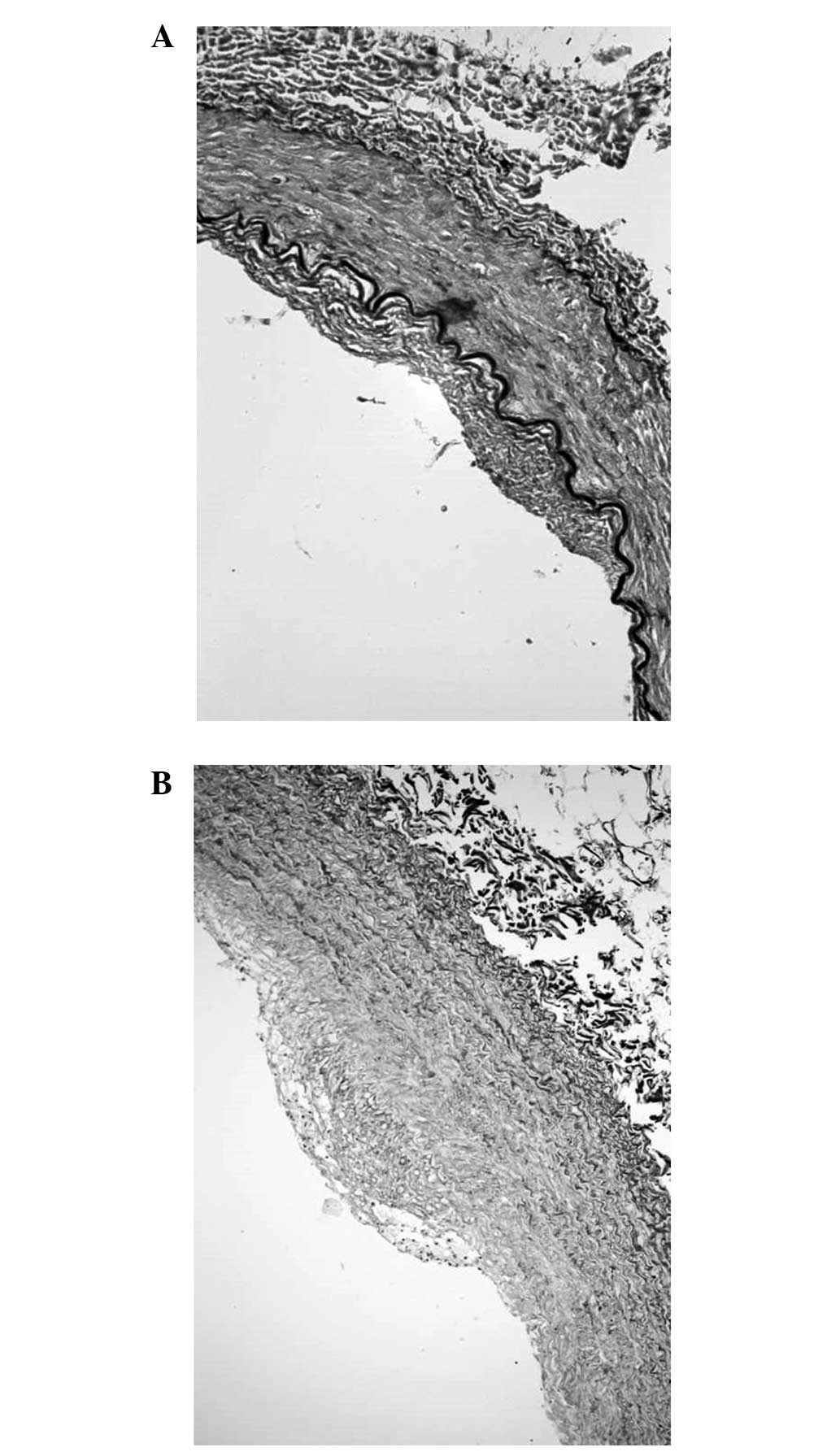|
1
|
Velazquez EJ, Lee KL, Deja MA, Jain A,
Sopko G, Marchenko A, Ali IS, Pohost G, Gradinac S, Abraham WT, et
al: Coronary-artery bypass surgery in patients with left
ventricular dysfunction. N Engl J Med. 364:1607–1616. 2011.
View Article : Google Scholar : PubMed/NCBI
|
|
2
|
Vassiliades T Jr: Enabling technology for
minimally invasive coronary artery bypass grafting. Semin Thorac
Cardiovasc Surg. 21:237–244. 2009. View Article : Google Scholar : PubMed/NCBI
|
|
3
|
Sabik JF III, Lytle BW, Blackstone EH,
Houghtaling PL and Cosgrove DM: Comparison of saphenous vein and
internal thoracic artery graft patency by coronary system. Ann
Thorac Surg. 79:544–551. 2005. View Article : Google Scholar : PubMed/NCBI
|
|
4
|
Tatoulis J, Buxton BF, Fuller JA, Meswani
M, Theodore S, Powar N and Wynne R: Long-term patency of 1108
radial arterial-coronary angiograms over 10 years. Ann Thorac Surg.
88:23–30. 2009. View Article : Google Scholar : PubMed/NCBI
|
|
5
|
Wijns W, Kolh P, Danchin N, Di Mario C,
Falk V, Folliguet T, Garg S, Huber K, James S, Knuuti J, et al: The
Task Force on Myocardial Revascularization of the European Society
of Cardiology (ESC) and the European Association for
Cardio-Thoracic Surgery (EACTS); European Association for
Percutaneous Cardiovascular Interventions (EAPCI): Guidelines on
myocardial revascularization. Eur Heart J. 31:2501–2555.
2010.PubMed/NCBI
|
|
6
|
Fattouch K, Sampognaro R, Speziale G,
Salardino M, Novo G, Caruso M, Novo S and Ruvolo G: Impact of
moderate ischemic mitral regurgitation after isolated coronary
artery bypass grafting. Ann Thorac Surg. 90:1187–1194. 2010.
View Article : Google Scholar : PubMed/NCBI
|
|
7
|
Beller GA and Ragosta M: Decision making
in multivessel coronary disease: The need for physiological lesion
assessment. JACC Cardiovasc Interv. 3:315–317. 2010. View Article : Google Scholar : PubMed/NCBI
|
|
8
|
Leacche M, Balaguer JM and Byrne JG:
Intraoperative grafts assessment. Semin Thorac Cardiovasc Surg.
21:207–212. 2009. View Article : Google Scholar : PubMed/NCBI
|
|
9
|
Turer AT and Hill JA: Pathogenesis of
myocardial ischemia-reperfusion injury and rationale for therapy.
Am J Cardiol. 106:360–368. 2010. View Article : Google Scholar : PubMed/NCBI
|
|
10
|
Tarakji KG, Sabik JF III, Bhudia SK,
Batizy LH and Blackstone EH: Temporal onset, risk factors and
outcomes associated with stroke after coronary artery bypass
grafting. JAMA. 305:381–390. 2011. View Article : Google Scholar : PubMed/NCBI
|
|
11
|
Kobayashi H, Kitamura S, Kawachi K, Morita
R, Konishi Y and Tsutsumi M: A pathohistological and biochemical
study of arteriosclerosis in the internal thoracic artery, a vessel
commonly used as a graft in coronary artery bypass surgery. Surg
Today. 23:697–703. 1993. View Article : Google Scholar : PubMed/NCBI
|
|
12
|
Otsuka F, Yahagi K, Sakakura K and Virmani
R: Why is the mammary artery so special and what protects it from
atherosclerosis? Ann Cardiothorac Surg. 2:519–526. 2013.PubMed/NCBI
|
|
13
|
Domanski MJ, Borkowf CB, Campeau L,
Knatterud GL, White C, Hoogwerf B, Rosenberg Y and Geller NL:
Prognostic factors for atherosclerosis progression in saphenous
vein grafts: The postcoronary artery bypass graft (Post-CABG)
trial. Post-CABG Trial Investigators. J Am Coll Cardiol.
36:1877–1883. 2000. View Article : Google Scholar : PubMed/NCBI
|
|
14
|
Jones WB, Riley CP, Reeves TJ and
Sheffield LT: Natural history of coronary artery disease. Bull N Y
Acad Med. 48:1109–1125. 1972.PubMed/NCBI
|
|
15
|
Allon M, Litovsky S, Young CJ, Deierhoi
MH, Goodman J, Hanaway M, Lockhart ME and Robbin ML: Correlation of
pre-existing vascular pathology with arteriovenous graft outcomes
in hemodialysis patients. Am J Kidney Dis. 62:1122–1129. 2013.
View Article : Google Scholar : PubMed/NCBI
|
|
16
|
Sulikowski T, Tejchman K, Ziętek Z,
Urasińska E, Domański L, Sieńko J, Romanowski M, Safranow K,
Zukowski M, Ciechanowicz A, et al: Histopathologic evaluation of
pretransplantation biopsy as a factor influencing graft function
after kidney transplantation in 3-year observation. Transplant
Proc. 42:3375–3381. 2010. View Article : Google Scholar : PubMed/NCBI
|
|
17
|
Selvin E, Najjar SS, Cornish TC and
Halushka MK: A comprehensive histopathological evaluation of
vascular medial fibrosis: Insights into the pathophysiology of
arterial stiffening. Atherosclerosis. 208:69–74. 2010. View Article : Google Scholar : PubMed/NCBI
|
|
18
|
Thiene G, Miazzi P, Valsecchi M, Valente
M, Bortolotti U, Casarotto D and Gallucci V: Histological survey of
the saphenous vein before its use as autologous aortocoronary
bypass graft. Thorax. 35:519–522. 1980. View Article : Google Scholar : PubMed/NCBI
|
|
19
|
Ruengsakulrach P, Sinclair R, Komeda M,
Raman J, Gordon I and Buxton B: Comparative histopathology of
radial artery versus internal thoracic artery and risk factors for
development of intimal hyperplasia and atherosclerosis.
Circulation. 100(19 Suppl): II139–II144. 1999.PubMed/NCBI
|
|
20
|
Tinică G, Luca C, Dumitraş EA and Butcovan
D: Pre-operative graft assessment before their use in aortocoronary
by-pass surgery. The 10th Congress of the Romanian
Society of Cardiovascular Surgery. International Hotel. (Iasi).
172014.
|











